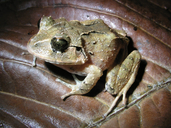|
Craugastor megacephalus (Cope, 1875)
Subgenus: Craugastor | family: Craugastoridae genus: Craugastor |
 © 2006 Brian Kubicki (1 of 16) |
|
|
|
Description Description: Craugastor megacephalus is a leaf-litter dwelling frog. The SVL of a male adult frog is 30 to 43 mm, and the SVL of a female adult frog is 50 to 70 mm. Snout is truncated in dorsal view and slightly obtuse in lateral view. Nares do not protrude. Upper eyelid is tuberculate. Tympanum is large. Vomerine odontophores are triangular in shape, and located posterior to the choanae with odontophore patches separated by a narrow medial gap. Large cranial ridges are present with knobs or bosses on the posterior end of the crests. These knobs are particularly evident on large females, above the supratympanic fold. This species has a set of chalice-shaped or hourglass-shaped plicae (dorsal ridges); parallel suprascapular plicae run to about midbody, and paired laterosacral ridges form either a V-shape or parallel lines on the posterior dorsum. The V-shape of laterosacral plicae is found in Nicaraguan, Honduran, and Costa Rican populations, while laterosacral plicae consisting of non-converging parallel ridges occur in populations from western Panama. Paravertebral plicae are absent. The dorsum of adults is smooth to shagreened with a few scattered, low pustules. Pustules present in juvenile Craugastor megacephalus are small with pale tips and usually pointed. The venter is smooth. One or two large tubercles are present on the heel. Tarsal fold is lacking. Juveniles have prominent tubercles on the outer tarsus, but tarsal tubercles are weakly developed in adults (Savage and Myers 2002). The dorsal surface of Craugastaor megacephalus is gray-tan to olive-brown, sometimes with a salmon cast. Large females especially may be dark brown. Individuals have black supratympanic folds (usually), a black spot on the tympanum (usually), black plicae, black sacral spots and enlarged sacral tubercles, and an indistinct lighter interorbital bar or blotch, bordered by slightly darker markings. Juveniles have a lighter ground color which makes the dark markings stand out more in constrast. Upper lip may have a lighter stripe, alternating dark and light bars, or uniform coloration. Lower orbit usually has adjacent alternating black and off-white spots. No paired dorsal stripes are present. Dorsal limb surfaces may be uniform or may have indistinct darker bars. Posterior thigh is dark brown to black and may be uniform or spotted or mottled. The posterior black seat patch is continuous with a black base that continues onto the undersurface of the thigh. On the ventral surface, the throat and chest are covered by a brown reticulum with large round light spots in juveniles and larger round dark spots in adults. Juveniles also have a series of lighter spots along the edge of the lower jaw. In Costa Rican C. megacephalus, the iris is black flecked with gold, while in Panama the iris may be bronze to brown, sometimes lighter in the lower half, rarely with greenish bronze tint, and with black venation or suffusion (Savage and Myers 2002). Juveniles from Costa Rica have yellow-orange to red-orange on concealed limb surfaces, on the posterior venter, and ventral surfaces of hands and digits (while the soles are brown). One juvenile from Panama had bright greenish yellow on all ventral surfaces (Savage and Myers 2002). Distribution and Habitat Country distribution from AmphibiaWeb's database: Costa Rica, Honduras, Nicaragua, Panama
Life History, Abundance, Activity, and Special Behaviors Trends and Threats Possible reasons for amphibian decline General habitat alteration and loss Comments A Spanish-language species account can be found at the website of Instituto Nacional de Biodiversidad (INBio).
References
Brem, F. R. and Lips, K. (2008). ''Batrachochytrium dendrobatidis infection patterns among Panamanian amphibian species, habitats and elevations during epizootic and enzootic stages.'' Diseases of Aquatic Organisms, 81, 189-202. Cooper Jr., W., Caldwell, J., and Vitt, L. (2008). ''Effective crypsis and its maintenance by immobility in Craugastor frogs.'' Copeia, 3(527-532). Cooper Jr., W., Caldwell, J., and Vitt, L. (2008). ''Escape responses of cryptic frogs (Anura: Brachycephalidae: Craugastor) to simulated terrestrial and aerial predators.'' Behaviour, 145, 25-38. Cope, E. D. (1875). ''Checklist of North American Batrachia and Reptilia.'' Bulletin of the American Museum of Natural History, 1, 31. Lieberman, S. S. (1986). ''Ecology of the leaf litter herpetofauna of a Neotropical rainforest: La Selva, Costa Rica.'' Acta Zoológica Mexicana, 15, 1-72. Noble, G. K. (1918). ''The amphibians collected by the American Museum Expedition to Nicaragua in 1916.'' Bulletin of the American Museum of Natural History, New York, 38, 311-347. Savage, J. M., and Myers, C. W. (2002). ''Frogs of the Eleutherodactylus biporcatus group (Leptodactylidae) of Central America and Northern South America, including rediscovered, resurrected, and new taxa.'' American Museum Novitates, 3357, 1-48. Solís, F., Ibáñez, R., Chaves, G., Wilson, L. D., and Bolaños, F. (2008). Craugastor megacephalus. In: IUCN 2010. IUCN Red List of Threatened Species. Version 2010.1. www.iucnredlist.org. Downloaded on 30 March 2010. Woodhams, D., Kilburn, V., Reinert, L., Voyles, J., Medina, D., Ibanez, R., Hyatt, D., Boyle, D., Pask, J., Green, D., and Rollins-Smith, L. (2008). ''Chytridiomycosis and amphibian population declines continue to spread eastward in Panama.'' EcoHealth, 5, 268-274. Originally submitted by: Christine Isabel Javier (first posted 2009-11-02) Edited by: Kellie Whittaker (2011-04-12) Species Account Citation: AmphibiaWeb 2011 Craugastor megacephalus <https://amphibiaweb.org/species/5988> University of California, Berkeley, CA, USA. Accessed May 16, 2025.
Feedback or comments about this page.
Citation: AmphibiaWeb. 2025. <https://amphibiaweb.org> University of California, Berkeley, CA, USA. Accessed 16 May 2025. AmphibiaWeb's policy on data use. |




 Map of Life
Map of Life